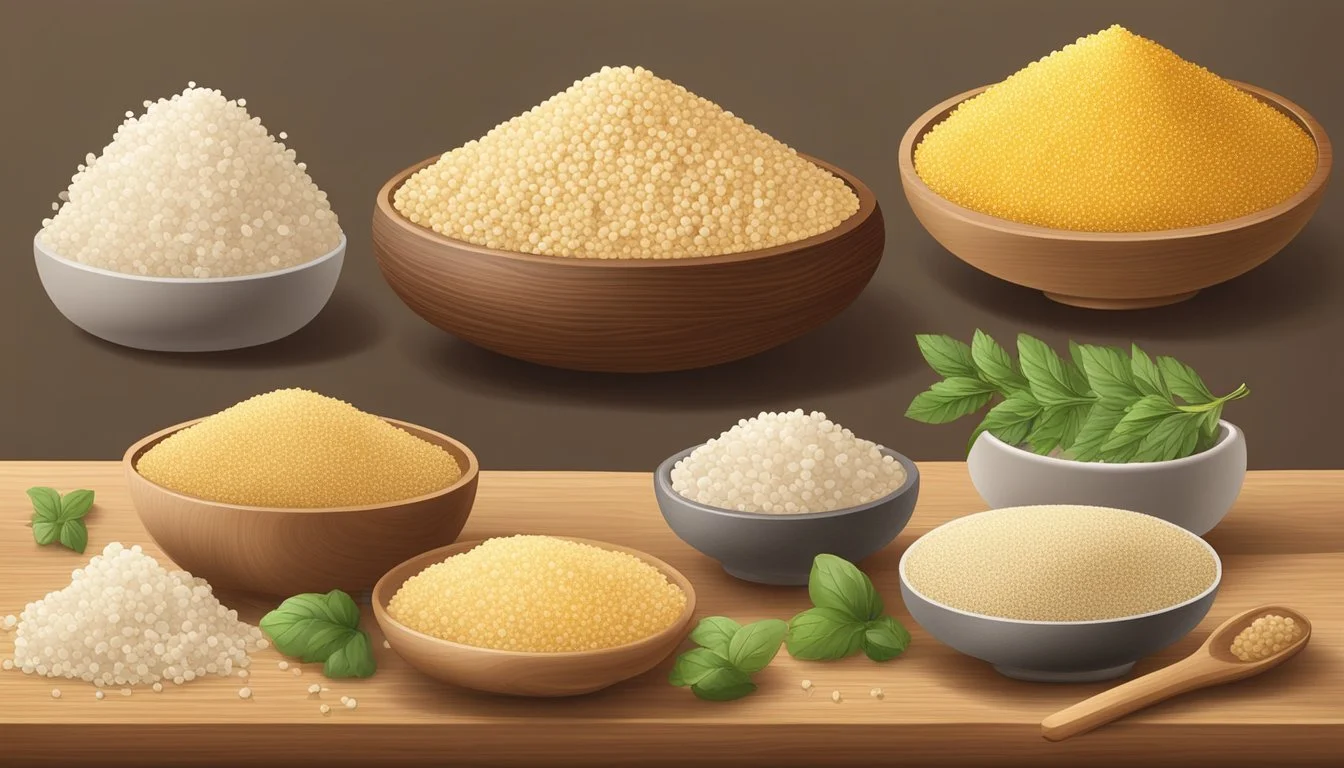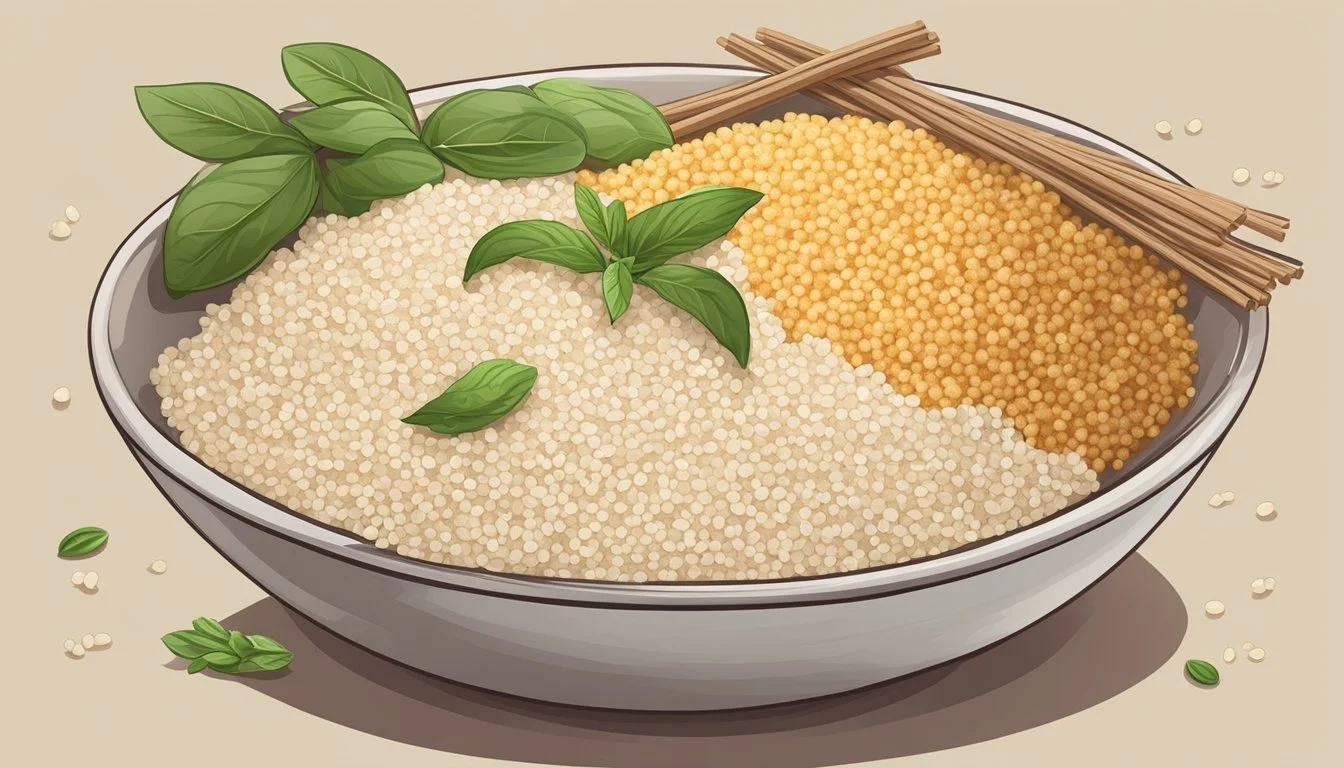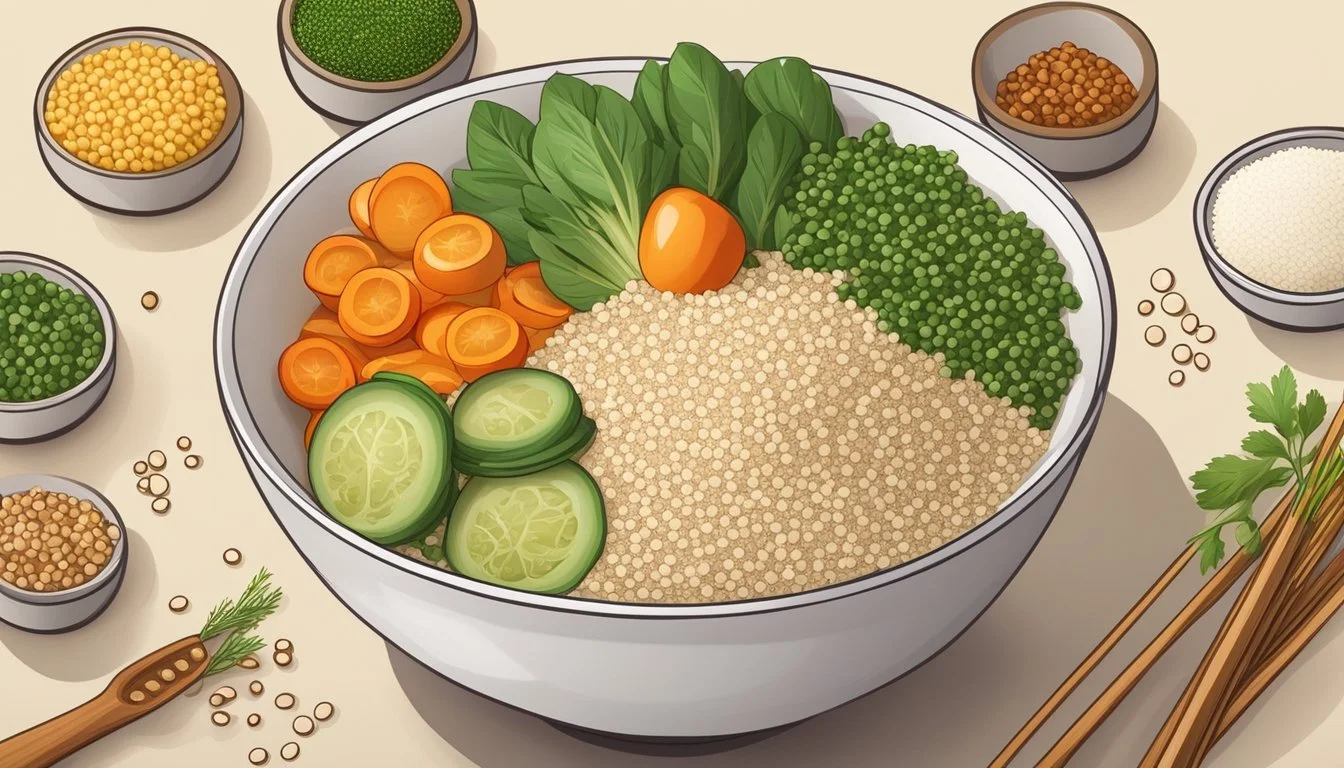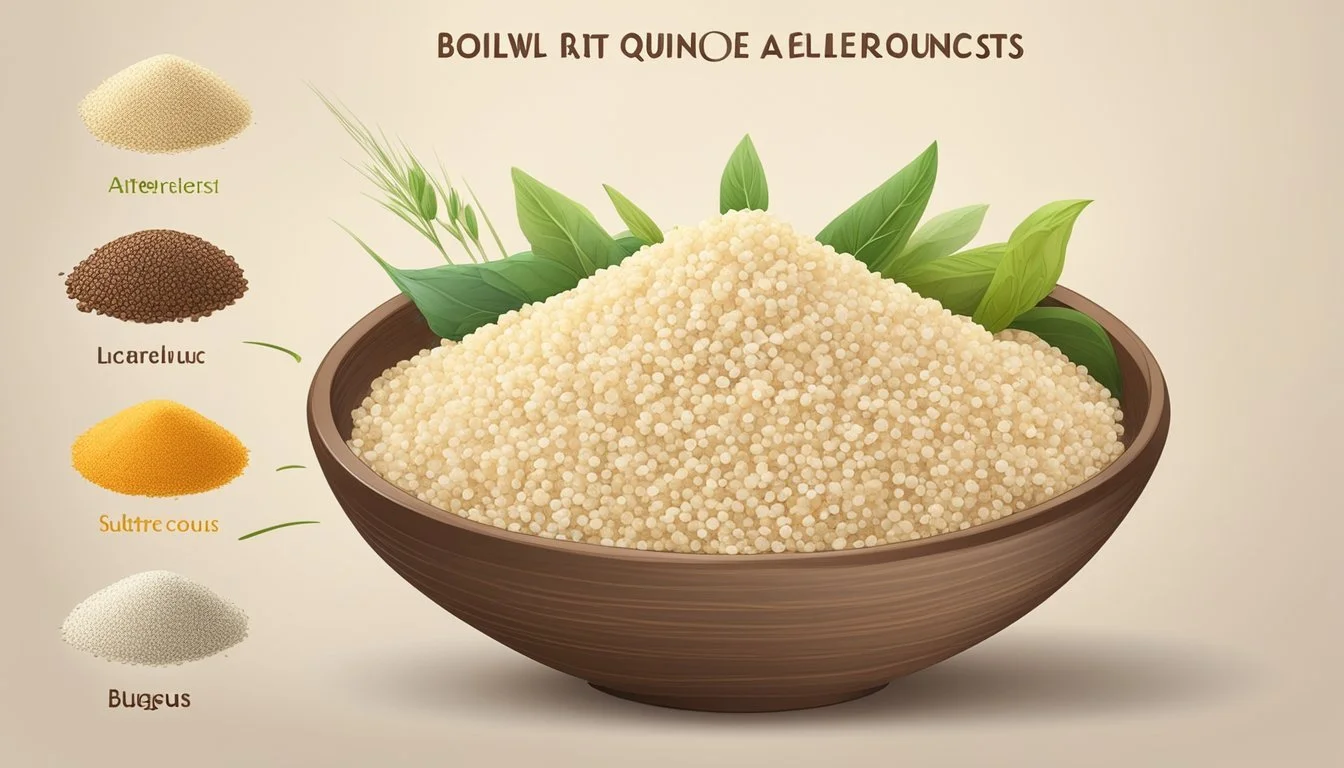White Quinoa Substitutes
Top Alternatives for Your Diet
For those seeking a hearty and nutritious substitute for white quinoa, several alternatives can seamlessly fit into various dishes. Brown rice, with its chewy texture and nutty flavor, makes an excellent stand-in for white quinoa. It offers a similar nutritional profile, rich in fiber and easily pairs with savory ingredients like chicken and fish.
Another option to consider is wild rice, which not only shares a similar texture to quinoa but also enhances the dish with its distinct, earthy flavor. For those in need of a quicker cooking grain, white rice can serve as a convenient replacement. It is particularly suitable for recipes necessitating a soft, fluffy texture.
These substitutes not only match the nutritional benefits of quinoa but also bring their own unique tastes and textures to your meals. Whether it's for a salad, burrito bowl, or side dish, exploring these alternatives can make your meals both healthy and flavorful.
Understanding Quinoa
White quinoa is a nutrient-dense seed often classified as an ancient grain. It is a highly versatile ingredient that offers numerous health benefits.
Nutritional Profile of White Quinoa
White quinoa is noted for its impressive nutritional profile. It is rich in protein, making it an excellent choice for vegetarians and vegans. Each serving contains all nine essential amino acids, classifying it as a complete protein. In addition to protein, white quinoa is high in fiber, aiding in digestion and maintaining healthy cholesterol levels.
The seed also boasts a wealth of minerals, including iron and magnesium. Iron supports vital functions such as oxygen transport in the blood, while magnesium is crucial for bone health and enzyme function. White quinoa's antioxidants, including quercetin and kaempferol, contribute to its health benefits by combating inflammation and free radical damage.
Culinary Uses of White Quinoa
White quinoa shines in the kitchen due to its mild flavor and versatility. It can be used in a variety of dishes ranging from salads to stir-fries. The neutral taste allows it to absorb flavors from other ingredients, making it suitable for both savory and sweet dishes.
In salads, it pairs well with vegetables, nuts, and dressings. When used in stir-fries, it serves as a nutritious base, complementing meats and sauces. Additionally, it can be cooked into a porridge for a hearty breakfast or incorporated into baked goods like muffins and bread.
White Quinoa Substitutes
White quinoa is prized for its high protein content, fiber richness, and versatile use in various dishes. If you're looking for alternatives, several grains, non-grain options, and gluten-free substitutes can match or complement white quinoa's nutritional profile and cooking methods.
Grains as Substitutes
Brown Rice: Brown rice is a readily available substitute for white quinoa. It has a similar cooking time and offers a robust nutritional profile, including fiber and essential minerals. Brown rice pairs well with savory dishes, making it a versatile addition to meals.
Wild Rice: This grain is another excellent substitute, known for its protein-rich and nutrient-dense properties. It has a slightly chewier texture compared to quinoa, adding a unique essence to salads and side dishes.
Barley: Barley, with its nutty flavor and chewy texture, makes a delightful replacement for white quinoa in soups and stews. It's packed with vitamins and minerals, although it is not suitable for gluten-free diets.
Non-Grain Alternatives
Cauliflower Rice: Riced cauliflower is a low-carb, vegetable-based substitute that absorbs flavors well, similar to white quinoa. It’s quick to prepare and adds a light, fluffy texture to dishes while keeping the calorie count low.
Broccoli Rice: This is another non-grain alternative that is both nutritious and easy to prepare. Broccoli rice provides a good dose of vitamins and minerals, and its mild flavor complements a variety of main courses.
Oatmeal: For breakfast or dessert recipes, oatmeal can stand in for quinoa, offering a creamy texture and a heart-healthy boost. It’s particularly useful in baking and porridge recipes.
Gluten-Free Options
Buckwheat: Despite its name, buckwheat is gluten-free and provides a nutty, earthy flavor. It's high in protein and fiber, making it a strong contender as a white quinoa substitute in pilafs and salads.
Amaranth: This ancient grain is nutrient-dense and suitable for various recipes that call for quinoa. It cooks quickly and has a distinctive, slightly sweet taste, enriching both savory and sweet dishes.
Teff: Teff is a tiny, gluten-free grain rich in vitamins and essential amino acids. It can be used similarly to quinoa in porridges and granolas, offering a slightly nutty flavor and a good nutritional profile.
Utilizing these substitutes can provide variety and cater to specific dietary needs while maintaining the health benefits associated with white quinoa. Each alternative brings unique flavors and textures to your dishes, enhancing your culinary experience.
Quinoa Substitute Cooking Tips
When substituting white quinoa, it's essential to consider cooking time, flavor pairings, and serving methods to ensure a seamless integration into your meals. Common substitutes include brown rice, wild rice, and even vegetables like broccoli. These substitutes can be easily adapted to match the nutritional benefits and versatility of quinoa.
Adjusting Cooking Time and Methods
Different quinoa substitutes vary in their cooking times and methods. Brown rice generally takes about 40-45 minutes, requiring more water than quinoa. Wild rice also requires a longer cooking time, around 45-50 minutes, and should be rinsed before cooking to remove any debris.
For quicker options, pasta and grits are ready in 10-15 minutes. If using broccoli florets, lightly steam or sauté them until tender. Adapting cooking methods can ensure substitutes blend seamlessly into dishes that traditionally include quinoa.
Flavor Pairing and Texture Considerations
When choosing a quinoa substitute, consider both flavor and texture. Brown rice pairs well with savory meats like chicken and fish due to its slightly nutty flavor. Wild rice has an earthy flavor and a chewy texture, making it ideal for salads and soups.
Broccoli florets offer a light, sweet flavor that complements roasted vegetables and stir-fries. Experimenting with flavor pairings can enhance the overall dish, ensuring the substitute adds to the meal's complexity without overpowering it.
Serving Suggestions
Substitute ingredients can be served in various ways to fit different dietary needs and preferences. Brown rice and wild rice are excellent bases for hearty salads or stir-fries with plenty of vegetables. They are also suitable for stuffing into bell peppers or acorn squash.
Pasta works well in Mediterranean dishes, and grits offer a Southern twist to breakfast bowls. Broccoli florets can be tossed into salads or serve as a delicious side. Serving these substitutes diversely can cater to a variety of tastes and dietary preferences, ensuring they integrate well into any meal plan.
Health and Dietary Considerations
White quinoa has a robust nutrient profile that makes it an excellent addition to various diets. The following sections explore its benefits for vegetarians and how it can help in managing dietary restrictions.
Benefits for Vegetarians
White quinoa is highly valued by vegetarians due to its status as a complete protein source. It contains all nine essential amino acids, which is uncommon for plant-based foods. This makes it a crucial addition to vegetarian diets that may lack sufficient protein sources.
The fiber content in white quinoa promotes healthy digestion, aids in maintaining stable blood sugar levels, and contributes to feelings of fullness. Additionally, quinoa is rich in important minerals like magnesium, iron, and zinc, which support overall health and may be harder to obtain from a plant-based diet.
Managing Dietary Restrictions
White quinoa is naturally gluten-free, which makes it an ideal choice for individuals with celiac disease or gluten sensitivity. Its versatility allows it to be incorporated into meals as a substitute for gluten-containing grains, without compromising nutrition or taste.
Those managing dietary restrictions related to heart health or blood sugar control can benefit from quinoa's high fiber and low glycemic index. It helps in maintaining healthy cholesterol levels and preventing spikes in blood sugar.
For those needing to avoid animal products or specific allergens, quinoa provides an excellent alternative, ensuring nutritional adequacy while adhering to dietary limitations.
Cultural and Historical Context
Quinoa has deep roots in South America and has been a staple and symbol for Andean communities. Its journey from ancient grain to global superfood highlights its cultural significance and trade impact.
Quinoa's Origins and History
Originating in the Andean region of South America, quinoa has been cultivated for thousands of years. This ancient grain, part of the grass family, was a primary food source for the Incas and other pre-Columbian civilizations.
They regarded quinoa as the "mother of all grains."
In their society, quinoa was often integrated into rituals and agricultural practices. The plant thrives in high-altitude regions and is adaptable to harsh growing conditions.
Its resilience made it a reliable crop for Andean farmers.
With colonization, quinoa faced a decline as European crops replaced native grains. Yet, it remained integral to local diets and traditions. Today, its historical and spiritual significance continues to resonate within Andean culture.
Global Impact and Trade
The rise of quinoa's popularity began in the 21st century, as global markets embraced it as a nutritious "superfood." Recognized for its high protein content and essential amino acids, quinoa offers a valuable alternative to conventional grains.
Its demand surged internationally, influencing trade patterns.
Countries like Bolivia and Peru became primary exporters, fostering economic growth within these regions. The inaugural 2013 International Year of Quinoa shone a spotlight on its benefits, propelling its status in the global market.
Although prices fluctuated, quinoa's importance as a commodity remains strong.
Now, it not only serves as a food source but also represents cultural exchange and the spread of Andean heritage worldwide. This has enabled Andean farmers to diversify their income while preserving their agricultural traditions.
Recipe Adaptations and Alternatives
When substituting white quinoa in recipes, it's essential to choose alternatives that maintain both the texture and nutritional profile. Different grains and non-grain options can be used effectively to adapt dishes without compromising flavor.
Recipes Using Grains as Quinoa Substitutes
Brown Rice: Brown rice is a fantastic substitute for quinoa. It pairs well with savory dishes like chicken stir-fries and fish. Its cooking time is slightly longer, but brown rice provides a chewy texture that holds up well in salads and side dishes.
Wild Rice: Wild rice offers a unique flavor and texture. It adds depth to soups and is delicious when combined with mushrooms. Wild rice also works well in salads, sides, and stuffed vegetables like peppers and squash.
Barley: Barley is another grain that can replace quinoa. It has a rich, nutty flavor and chewy texture. Barley excels in warm salads and casseroles, particularly those that include roasted vegetables.
Millet: Millet is a lesser-known grain that can substitute quinoa. It cooks quickly and absorbs flavors well. Millet's mild taste makes it ideal for breakfast bowls, salads, and even stuffed vegetables.
Recipes Using Non-Grain Quinoa Substitutes
Cauliflower Rice: Cauliflower rice is a popular low-carb alternative. It works well in stir-fries and as a base for burrito bowls. Quick to prepare, it retains a slightly crunchy texture that adds freshness to dishes.
Lentils: Lentils can stand in for quinoa in many recipes. Their earthy flavor and rich protein content make them suitable for salads and soups. Lentils cook relatively quickly and can be used in vegetarian pasta dishes to add substance.
Chickpeas: Chickpeas offer a hearty texture and mild flavor. They can replace quinoa in cold salads and warm grain bowls. Often found in Mediterranean cuisine, chickpeas are also a good source of protein and fiber.
Using these substitutes allows for flexibility in recipe adaptations, ensuring that dishes remain nutritious and flavorful.
Additional Resources and Guides
To aid in navigating the world of quinoa substitutes, the following resources offer in-depth knowledge. From cookbooks to expert advice, these tools provide valuable information tailored to individual dietary needs and preferences.
Cookbooks and Cooking Shows
Cookbooks provide an array of recipes and tips on how to cook with quinoa substitutes. Notable titles include "The Gluten-Free Grains Cookbook" by Quelcy Kogel, which includes a variety of ancient grain recipes, and "Grains for Every Season" by Joshua McFadden. These books offer detailed methods to integrate alternatives like teff, millet, and amaranth into meals.
Cooking shows such as "America's Test Kitchen" often feature episodes dedicated to healthy grains. Watching these shows helps viewers understand how to properly prepare and cook with quinoa substitutes, ensuring meals are both nutritious and palatable. These resources enhance cooking versatility and help diversify diets.
Nutritional and Dietary Experts
For those seeking personalized advice, consulting with a registered dietitian or nutritionist is beneficial. Experts provide tailored nutritional guidance, ensuring individuals meet dietary restrictions and health goals. Dietitians can help craft meal plans that incorporate quinoa substitutes, balancing protein, fiber, and essential amino acids intake.
Organizations like the Academy of Nutrition and Dietetics offer directories to find certified professionals. Online platforms such as Nutritious Life by Keri Glassman provide extensive resources and articles about maintaining a healthy diet using various grains, ensuring you receive the necessary nutrients while exploring quinoa alternatives.







